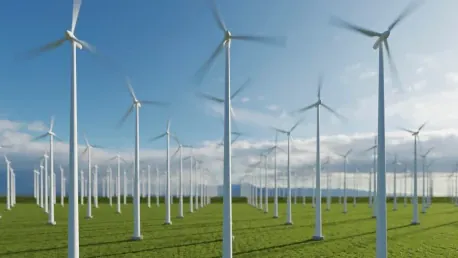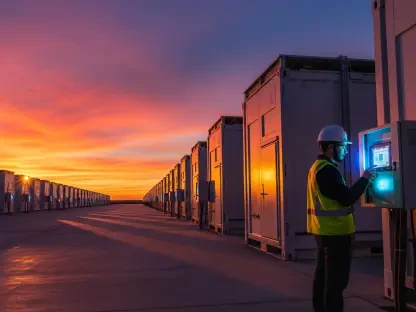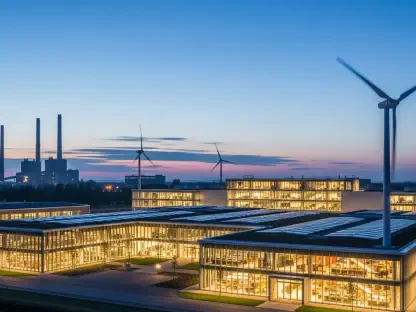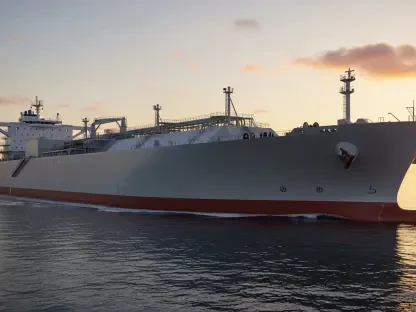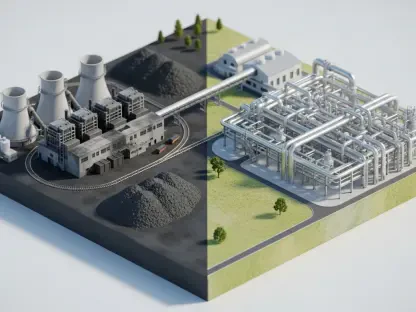Offshore wind energy is integral to the European Union’s plan to double its share of renewables by 2030. The target is for 42.5% of electricity in the region to come from green sources, requiring offshore wind capacity to rise from 204 GW to 450 GW. Numerous challenges such as grid connections and supply chain issues could impede this progress.
Grid Connection Issues
Insufficient Grid Infrastructure
The quest to meet the EU’s renewable energy targets is hindered by the complexity of the build process rather than the targets themselves. The grid infrastructure is frequently cited as a major stumbling block, with offshore wind projects experiencing delays due to inadequate grid connections. This inadequacy in current grid capabilities not only hinders the pace at which offshore wind energy can be integrated but also leaves many projects hanging in the balance. Adding to the challenge is the reliance on outdated national wind and solar targets, which fail to align with the rapid advancements in renewable energy technologies.
A report by Ember this year revealed that 11 out of 26 grid plans across Europe are based on these outdated metrics. This disparity between grid development and renewable energy progress means the infrastructure is unable to support the desired growth in offshore wind capacity. The lag in grid advancements forces many projects to remain in limbo, delaying the critical shift towards greener energy sources. It is imperative for new policies and updated targets to be implemented to align grid development with renewable energy goals.
Streamlining Permits and Partnerships
Addressing the grid connection issues involves more than just upgrading the existing infrastructure; it also requires policy and procedural reforms. Proposals have been made to establish ‘acceleration areas’ where permits can be granted more swiftly, reducing bureaucratic hurdles that slow down progress. Streamlined approval processes and strategic supply partnerships are suggested solutions to expedite wind farm construction. The idea is to create an environment where projects can move from planning to execution without the delays currently plaguing the sector.
However, these theoretical solutions must be translated into practical actions. The construction of wind farms necessitates not only the right approvals but also reliable supply partners who can meet stringent sustainability requirements. Future projects will soon be required to report their full scope of emissions, from construction to operation, making it crucial to ensure every step of the process adheres to sustainability standards. The combined efforts of policy reform and strategic partnerships could catalyze the growth needed to meet the 2030 renewable energy targets.
Supply Chain Challenges
Supply Chain Limitations
The supply chain for offshore wind projects is currently too small and underdeveloped to meet the ambitious targets set by the European Union. The complexity of the supply chain, which includes the production, transportation, and installation of turbines, poses significant challenges. Transport and logistics issues stand out as notable obstacles, often leading to delays in equipment turnaround times and extending project timelines. Procuring necessary materials and components is further complicated by the growing need to assess suppliers’ ESG (Environmental, Social, and Governance) credentials.
A recent report highlighted that equipment turnaround time and supplier credentials are major concerns within the supply chain. The need for suppliers who meet stringent environmental standards reduces the pool of available partners, thus complicating the already intricate logistics associated with offshore turbine construction. The shortage of suppliers capable of delivering sustainable power generation components on time is another critical issue that must be addressed to ensure the growth of offshore wind energy.
Demand for Temporary Power Solutions
The need for scalable temporary power solutions at offshore sites has become increasingly apparent. The Race to Renewables report by Aggreko underscores the importance of reliable on-site power generation for the successful construction and commissioning of new wind sites. Offshore wind projects are particularly demanding due to their remote locations and harsh environmental conditions. The lack of a stable power supply can significantly hamper progress, making temporary power solutions indispensable.
The Aggreko report clarifies that multiple and single wind turbine startups present significant challenges. Access to local power for erecting turbines and conducting heavy-lift vessel operations is essential to maintain a smooth construction timeline. Insufficient energy storage capacity and lack of access to temporary power solutions are major impediments identified by 40% of respondents in Germany and the UK, who flagged grid connections as an increasing challenge. Ensuring a versatile power supply that can adapt to the variable demands of offshore construction is critical to the success of these projects.
Environmental and Efficiency Concerns
Emissions Regulations
Environmental concerns have taken center stage in the discourse on offshore wind energy projects, particularly with respect to emissions regulations. A significant portion of emissions in offshore wind projects arises during the manufacturing and erection of turbines. Stringent emissions regulations are essential for minimizing the environmental impact of these massive constructions. Survey data highlights that nearly half of the respondents identified emissions as their top environmental concern, underscoring the need for more sustainable practices throughout the project lifecycle.
Reducing emissions during construction involves several strategies, including the use of more efficient machinery, optimizing logistics to reduce transportation-related emissions, and selecting materials with lower environmental impact. These measures are crucial not only for regulatory compliance but also for advancing the overarching goal of reducing carbon footprints across the energy sector. As offshore wind energy expands, adhering to rigorous environmental standards becomes imperative to ensure that these projects contribute positively to the EU’s decarbonization goals.
Efficiency Monitoring
In addition to emissions control, efficiency in both construction and operational phases is critical. Nearly 45% of respondents from the Aggreko survey emphasized the importance of remote monitoring for equipment efficiency. The ability to monitor and optimize the performance of construction equipment in real-time can lead to significant improvements in overall project efficiency. Enhanced coordination and the adoption of modern technologies are necessary to meet national wind capacity goals and operational efficiency.
Improved asset performance and efficient use of resources ensure that projects are completed within set timelines and budgets. Remote monitoring technology allows for proactive maintenance and quick resolution of technical issues, minimizing downtime and enhancing productivity. By integrating these advanced monitoring systems, stakeholders can streamline operations and ensure that the ambitious offshore wind capacity targets are met.
Technical and Knowledge Barriers
Technical Support Necessity
Access to cutting-edge technologies and robust technical support is essential for the smooth execution of offshore wind projects. The Race to Renewables report indicates that battery hybrid generation is a commonly adopted green technology in constructing new offshore wind farms. However, the cost associated with these technologies frequently acts as a barrier to wider adoption. Technical support remains paramount, as it ensures that the latest innovations are effectively integrated into the project lifecycle, from planning through execution.
The need for specialized technical support is particularly critical given the unique challenges posed by offshore wind construction. Harsh marine environments and the technological complexity require expertise that not all suppliers may possess. Thus, securing technical support that ensures reliability and efficiency throughout the project phases is crucial. Frequent updates and training on the latest technological trends and innovations in offshore wind can further bolster project outcomes and effectiveness.
Knowledge and Experience Gaps
Another significant hurdle identified in the offshore wind sector is the gap in technical knowledge and expertise. Approximately 41% of respondents from the Aggreko survey admitted to lacking sufficient technical knowledge in offshore wind technologies. This gap can significantly hinder the progress, as the successful execution of projects requires a deep understanding of both the technical and operational aspects of offshore wind energy.
Effective training programs and knowledge-sharing initiatives are necessary to bridge this gap. Stakeholders must invest in continuous education and industry-specific training to build a knowledgeable workforce capable of managing the complexities of offshore wind projects. Collaborative efforts between educational institutions, industry experts, and companies can cultivate a talent pool that is well-equipped to handle future challenges.
Collaboration and Future Steps
Bridging Power Provision Gaps
Collaboration among project stakeholders is critical to addressing gaps in power provision, fuel management, and transportation. The smooth transition to renewables requires expertise and experience, which can be sourced through strategic partnerships. Project stakeholders must engage with partners who possess a thorough understanding of the offshore wind market and its inherent challenges. Working together facilitates timely equipment deliveries, reduces delays, and ensures efficient project completion.
Overcoming the existing challenges requires proactive measures and a willingness to adopt new approaches. Power provisioning is a cornerstone of offshore wind project success, hence the need to engage with partners who can offer scalable and reliable power solutions. Focused efforts on logistics coordination and fuel management will mitigate risks and streamline project operations.
Comprehensive Lifecycle Planning
Offshore wind energy plays a critical role in the European Union’s aim to significantly increase its share of renewable energy by 2030. The EU’s ambitious goal is to ensure that 42.5% of the region’s electricity originates from green energy sources, which entails a substantial boost in offshore wind capacity. Specifically, this capacity needs to expand from the current 204 gigawatts (GW) to an impressive 450 GW within the next several years. However, this transition is not without its hurdles. Challenges such as ensuring adequate grid connections and overcoming various supply chain issues pose significant threats to achieving this ambitious target. Addressing these obstacles is crucial to meeting the EU’s renewable goals and ensuring a sustainable energy future. The success of this initiative depends heavily on strategic planning and international cooperation to mitigate these challenges and leverage the full potential of offshore wind resources.
